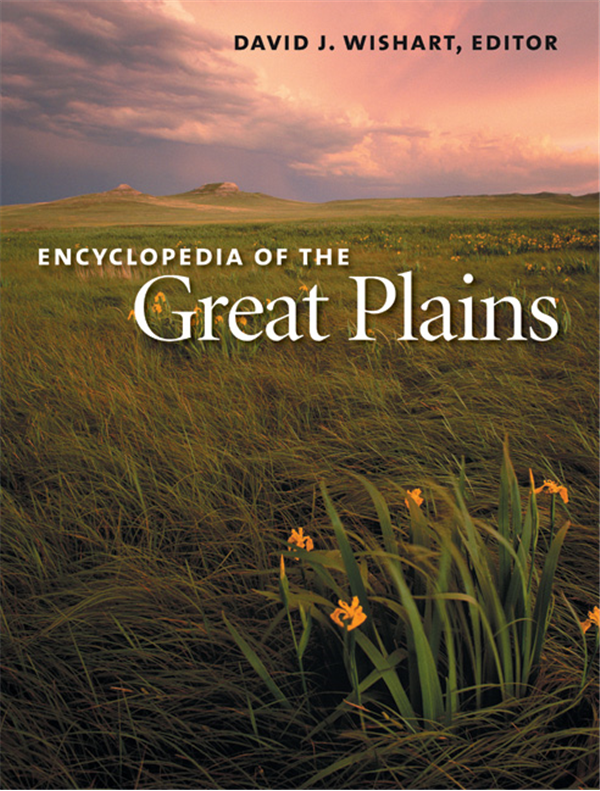The Great Plains is a vast expanse of grasslands stretching from the Rocky Mountains to the Missouri River and from the Rio Grande to the coniferous forests of Canada—an area more than eighteen hundred miles from north to south and more than five hundred miles from east to west. The Great Plains region includes all or parts of Texas, New Mexico, Oklahoma, Kansas, Colorado, Nebraska, Wyoming, South Dakota, North Dakota, Montana, Alberta, Saskatchewan, and Manitoba. The region, once labeled "the Great American Desert," is now more often called the "heartland," or, sometimes, "the breadbasket of the world." Its immense distances, flowing grasslands, sparse population, enveloping horizons, and dominating sky convey a sense of expansiveness, even emptiness or loneliness, a reaction to too much space and one's own meager presence in it.
The Plains region is the home of the Dust Bowl, the massacre at Wounded Knee, the North-West Rebellion, the Tulsa race riot, the Lincoln County War, the purported Roswell alien landing, and the Sturgis Motorcycle Rally. Its products have included furs, cattle, corn, wheat, oil, gas, and coal as well as jazz, literature, and political reform. It has been inhabited for more than twelve thousand years, since Paleo-Indians hunted mammoth and bison. More recent emigrants came from eastern North America, Europe, Latin America, and Asia, resulting in a complex and distinctive ethnic mosaic.
With 1,316 entries contributed by more than one thousand scholars, this groundbreaking reference work captures what is vital and interesting about the Great Plains—from its temperamental climate to its images and icons, its historical character, its folklore, and its politics.

Online Encyclopedia of the Great Plains
Encyclopedia of the Great Plains Indians
Chapters
- African Americans
- Agriculture
- Architecture
- Art
- Asian Americans
- Cities and Towns
- Education
- European Americans
- Film
- Folkways
- Gender
- Hispanic Americans
- Images and Icons
- Industry
- Law
- Literary Traditions
- Media
- Music
- Native Americans
- Physical Environment
- Politics and Government
- Protest and Dissent
- Religion
- Sports and Recreation
- Transportation
- War
- Water
The Encyclopedia is a single volume more than 900 pages with:
- 27 major topics
- an interpretive essay introducing each topic
- 20-60 shorter, individual entries per topic
- special attention to different experiences by gender, race, and ethnicity
- extensive cross-referencing
- a detailed index
- many maps and illustrations
Published September 2004. To purchase a copy, please contact the University of Nebraska Press.
The Encyclopedia of the Great Plains was produced from 1995 to 2003 with financial support from the National Endowment for the Humanities in the form of two major grants as well as the funds for the cumulative index. Generous support was also provided by the Nebraska Humanities Council; the government of Canada, through the Canadian Embassy in Washington DC; the University of Nebraska Foundation, which raised matching funds from its own endowment, and from Cliff's Foundation, D.B. and Paula Varner, and Frank Hilsabeck; and the Vice Chancellor for Research, the Arts and Sciences Deans Office, the Humanities Center, and the Center for Great Plains Studies, all at the University of Nebraska-Lincoln.
Editor
David Wishart, Professor of Geography, University of Nebraska - Lincoln.
Project Managers
Scarlett Presley (1995-1999), Sonja Rossum (1999-2002)
Research Assistants
Beth Ritter (1995-1999)
Akim Reinhardt (1996-1997)
Pekka Hämäläinen (1996-1998)
Sonja Rossum (1997-1999)
April L. Whitten (1997-1998)
Robert Watrel(1998)
Mark R. Ellis (1999-2001)
Charles Vollan (2000-2002)
Regional Editors
Pamela Brink, President of Associated Authors & Editors, Inc., Lubbock, Texas
Nancy Tystad Koupal, Director of Publications, South Dakota State Historical Society
Theodore Regehr, Professor of History, University of Calgary
Associate Editors from the University of Nebraska
J. Clark Archer, Associate Professor of Geography
Frances W. Kaye, Professor of English
John R. Wunder, Professor of History
Martha Kennedy, Library of Congress, Former Curator of the Great Plains Art Museum